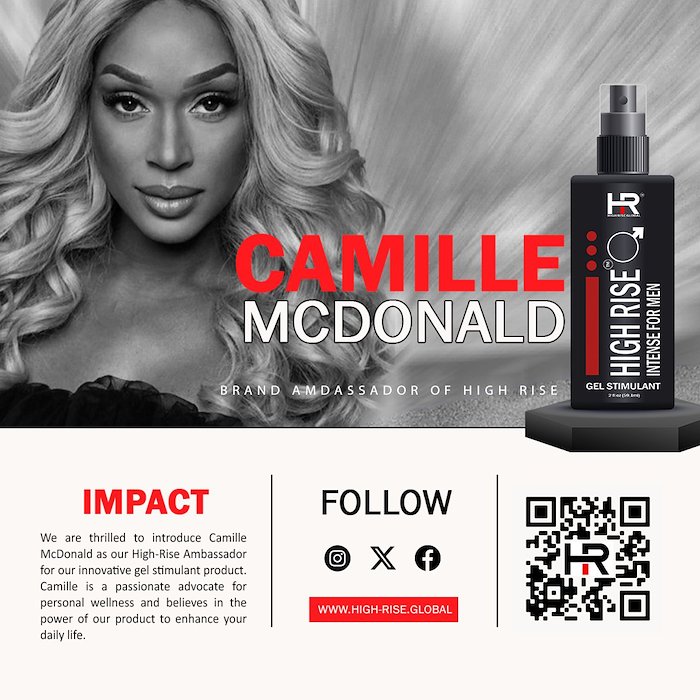
High Rise Campaign featuring Camille McDonald

High Rise Campaign featuring Camille McDonald
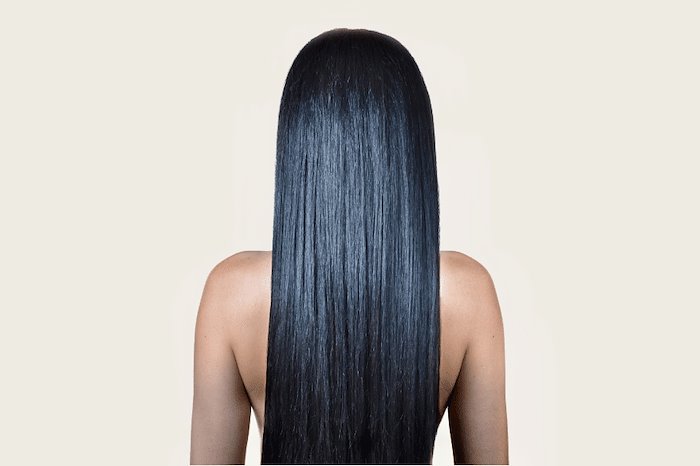
Fabric of Hair Investigates: WHAT IS A SILK PRESS 🧐
The procedure has been around for a very long time, but the name came from a play on words: pressing the hair with a flat iron to make it silky smooth. It is temporary and hair styling options that will revert back to its natural state once the hair is washed.
Our silk press technique at Pretty In A Minute is the stylist go to tool, the 2”Keratin flat iron and Ez comb combination that students and professionals adore.
Our Keratin flat iron is a styling tool with ceramic and titanium 50/50 blended plates, infused with Keratin that can straighten and smooth and create shine on any texture of hair.
A silk press with the 2” Keratin flat iron will leave your hair smooth, glossy, full of movement with amazing shine. On the other hand, a commercial flat iron can leave the hair feeling stiff and dehydrated.
A Silk Press is a temporary hairstyle that takes smoothing with Pretty In A Minute 2” Keratin straightener to another level , that elevates you’re texture to a glossier, silkier performance. Giving a lot of body and movement without using a relaxer or the chemicals.
There are several reasons that hair professionals specialize in the Silk Press, or Keratin Techniques; It is so that they can offer this service option in salon, and guarantee their clients receive the best results.
HOW DO YOU MAINTAIN A SILK PRESS?
Silk press can last with proper care up to two to three weeks. But as with any straightened style, you need to factor in the weather.
Longevity is dependent on a person’s lifestyle and the climate. I don’t recommend getting a silk press when there’s over 25% humidity, it will be a waste of time and money.
Minimize your hair's exposure to water, suggested wrapping the hair at night, wearing a shower cap and definitely no swimming.
SILK PRESS HAIR TIPS
Keep in mind once you have a silk press, or before you even have one. If you want a silk press so glossy it could catch a satellite’s attention, you need to factor in how you’re taking care of your hair before you sit in a stylist’s chair.
Ultimately, healthy hair can achieve that beautiful shine. So one should make sure that their hair is healthy and hydrated in order to get the best out of their silk press.
Note: Important to remember, a silk press is something to do once in a while to switch up your style.
It’s not a bi-weekly salon appointment style. this is where damage can happen.
The Good News is: There are professionals with certifications and experts in this texture enhancing process.💛💛💛💛💛
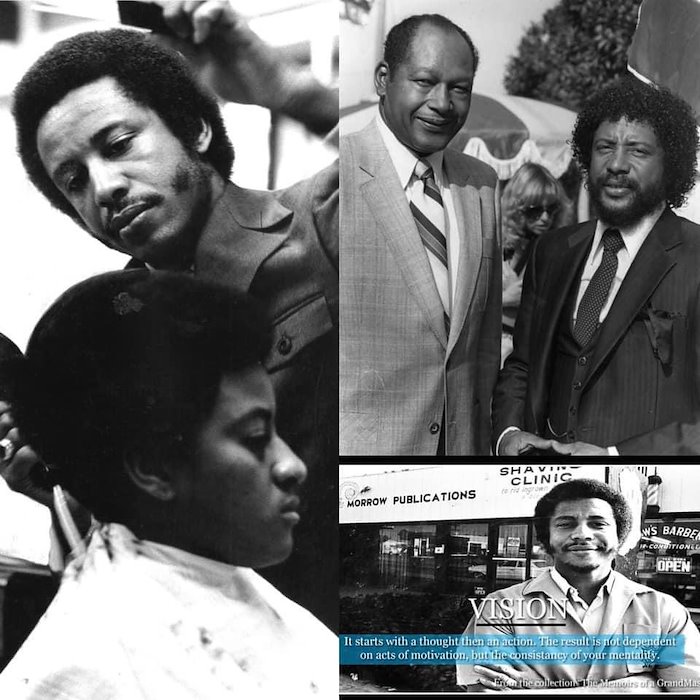
Fabric of Hair Educates: Willie Lee Morrow
Willie Lee Morrow, a barber turned entrepreneur who helped popularize tools such as the Afro pick and styles including the one dubbed the Jheri curl over more than half a century as an innovator in Black hair care, died June 22 at his home in San Diego. He was 82.
Mr. Morrow started his career at age 12 or 13 as what he described as a “stump barber,” with a tree stump as his barber chair, in the tiny Alabama locality where his parents worked as sharecroppers.
In pursuit of greater economic opportunity, he moved in 1959 to San Diego, where he established himself as a go-to stylist in the African American community and, eventually, one of the city’s most prominent Black business leaders as the founder of a hair-care supply empire.
The tools and products he developed, including combs used to create the Afro hairstyle popular in the 1960s and 1970s and a line of creams formulated to produce the looser curls that later came into fashion, made him one of the most influential figures in the history of how Black hair is cared for and viewed in society.
“Ever since there was racism, ever since there was discrimination against Black bodies, there was discrimination against Black hair as well.” With hair, the individual demonstrates his or her social significance, philosophical and cultural legacy,” he wrote in “400 years without a comb” a 1973 book that was one of multiple volumes he published about the history and practice of Black hair styling. “Hair is the basic, natural symbol of things people are or want to be everywhere and the social-cultural significance of a hairstyle should not be underestimated.”
For generations, many Black people seeking acceptance in White society felt pressure to straighten their hair to conform to White notions of beauty, a time-consuming, expensive process that often damaged the hair and scalp.
The early years of Mr. Morrow’s career coincided with the rise in popularity of the Afro, a hairstyle that showcased natural texture and became a symbol of Black pride.
At the time, there were few suitable styling tools for the Afro. “You know what people would use?” Mr. Morrow once told a Reporter; “Angel food cake cutters.” After an acquaintance traveled to Africa in 1962 and brought back a hand-carved African hair comb.
Mr. Morrow began crafting similar models that in time were selling 12,000 units a week. Mr. Morrow is noted as “the man who first mass-produced the plastic Afro pick” in the United States.
He was one of the first people to publicly proclaim that Black hair is a cultural contribution to American history, as well as a way that Black people came together and formed traditions and rituals and language and all of these things that really define what is Black culture.
He was one of the first people to publicly proclaim that.
Facts!! ⭐️⭐️⭐️⭐️⭐️
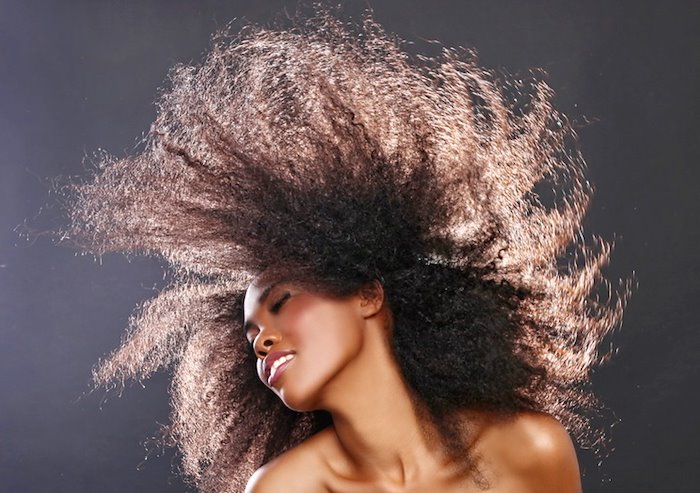
Fabric of Hair Investigates: What Is Hair Density and Why It Matters🧐
You can categorize your hair in many ways by its length, color, texture, or density. Your hair density refers to how many strands of hairs grow per square inch of your scalp.
Hair density is one factor that determines best techniques to style your hair.
It’s not necessary to get scientific and get out a microscope, to start counting individual strands on your head.
Just having a general idea about whether your hair density is on the thin or thick side can help you determine what type of hair products you should be using.
What’s typical hair density?
Your hair density is generally highest at your vertex, the area at the back of your head also known as your crown.
Hair density varies widely from person to person and tends to differ by ethnicity.
There’s no such thing as a hair density that’s too high or too low, and your hair density isn’t indicative of your overall health.
However, people with nutritional deficiencies may experience hair loss that reduces overall hair density.
What your hair density means for the care of your hair:
Knowing your hair density can give you an idea of what type of hair products will work best for your hair type.
Keep in mind that your hair coarseness, length, and texture, as well as your individual style play a role, too.
Low-density
If you have low hair density, you may want to avoid heavy products that weigh your hair down like heavy oils and conditioners. Look for products that can add volume to your hair like volumizing shampoos, dry shampoos and mousse. Experiment with hairstyles that add more volume to your hair can help give your hair a thicker appearance.
Medium-density
If your hair density falls somewhere in the middle, you don’t need to do much to change the volume of your hair.
You can focus on products that help keep your hair healthy while experimenting with different hairstyles and products.
High-density
If you have a higher hair density, you may need heavier styling products like gels and butters to get your hair to stick and keep it under control. Serums and oils can help reduce frizz.
Hairstyles that remove excess bulk may work best. Layering can help give your hair an illusion of being thinner, and by all means avoid getting blunt cuts.⭐️⭐️⭐️⭐️⭐️
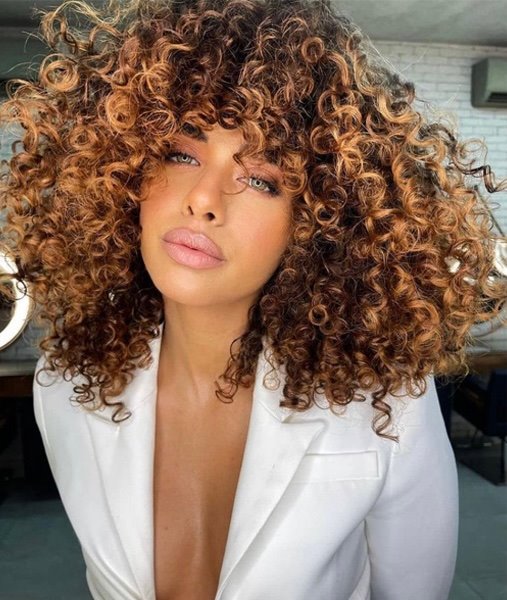
Fabric of Hair Educates: Curly Textured Hair Trendzz:
If you have to ask if highlights look good on curly hair? You are definitely not in the knowledge pool of textured and curly hair.
Yes highlights look seriously gorgeous on spiral strands, adding just the right amount of definition to a already defined hair texture.
There’s something about the shifting of the seasons, the changing of the leaves, and switching of the Starbucks drink menu that makes people want to completely overhaul my life each fall. Trending fall hair colors can make a person feel like a whole new person instead.
Just adding a few highlights or a gloss can give you a whole new vibe, if you, feel like your life needs something new and exciting, try swapping your beachy summer hair for a cozier fall shade.
Color processing can affect hai texture due to the chemicals involved, making your curls less tight and curly. Getting highlights is a much gentler way to color your hair, compared to all-over dye, and, if done right, they do not compromise the health of curly locks. This is why highlighting is often considered the best hair color for curly hair.
Balayage is currently one of the most popular coloring techniques that, thanks to flawless blending of hues, achieves a very natural look. Another great option for getting highlights that is specifically designed for curly hair is pintura highlights.
Note: this method means “painting” in Brazilian Portuguese and was founded by Brazilian hairstylist Dennis Da Silva.
Tight curls don’t reflect the light as much as wavy or straight hair, so with pintura technique, a lot more color is applied.
Color is hand-painted from the tips upwards, where light would naturally fall, to create stunning highlights, because no foil or heat is involved, it’s a healthier option for your curly locks.
To prevent any hair dye damage, make sure you work with a stylist who is a pro with curly hair. It also helps to have the healthiest hair possible before heading out for a dye job.
Make sure your locks are well-nourished, use a good conditioner, and always follow up with a good hair care routine.
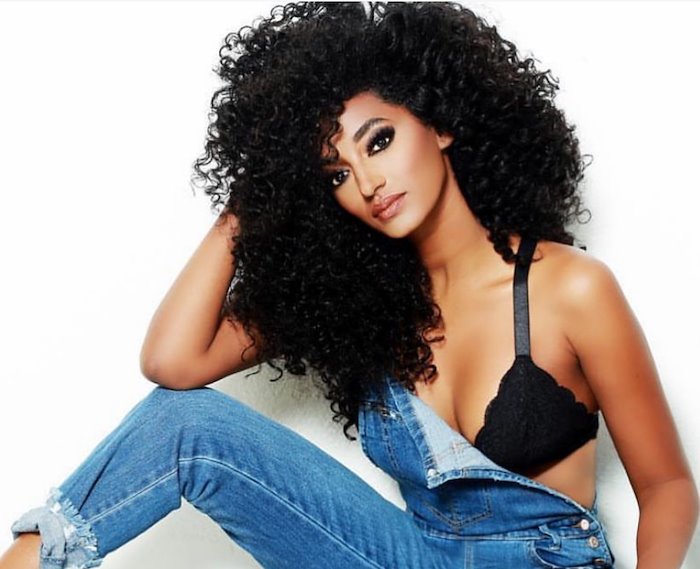
Fabric of Hair Educates: Hydration Inside and Out for Amazing Hair⭐️⭐️⭐️⭐️⭐️
We love an iced coffee as much as anyone, but as the temperature heats up, it's important to ensure you're getting your daily recommended water intake. Summer favorites like cold brew lattes, margaritas, and sangria are delicious🍸and dehydrating.
When combined with the heat, this is a recipe for disaster, including but not limited to dried-out hair and skin.
A good rule of thumb is that for every dehydrating beverage you drink, be sure to drink one extra glass of water.
You can continue to prioritize summer wellness by snacking on moisture-dense foods like cucumber, watermelon, cantaloupe, strawberries, and grapefruit. Pair a few healthy treats with your next coffee break to keep you energized and hydrated throughout the day.
When it comes to targeted hydration for curls, try a summer DIY project!
Create your own moisturizing hair spray. Start with a water-soluble base like glycerin, mix a dash of your favorite oil ( I recommend coconut or argon oil), add a pinch of aloe for shine and curl clarifying magic, and spritz lightly with lavender or essential oil of your choice.
Simply spritz your DIY hydration mist liberally before heading out into the sun.
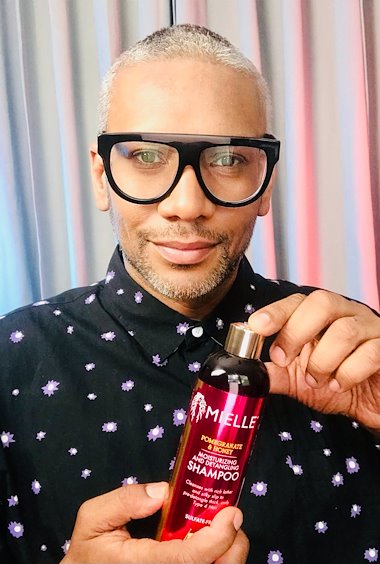
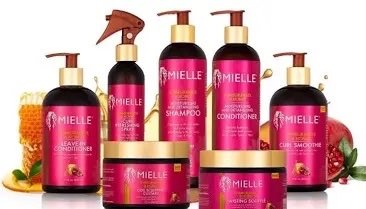
Fabric of Hair Review:Mielle Pomegranate & Honey Moisturizing and Detangling Shampoo🤩
Mielle’s Pomegranate & Honey Moisturizing and Detangling Shampoo uses natural ingredients like honey and babassu oil to lift dirt and oil from your hair while preserving moisture.
Enjoy the luxurious lather and amazing scent, and see for yourself how well it works at loosening tangles and adding slip.
Follow up with the Detangling Conditioner, moisturize with the Leave-In Conditioner, and get creative with your choice of Pomegranate & Honey natural hair styling products.
Love this product, I look forward to my 2 daughter's next Wash Day with it. My experience with my girls was amazing, and the smell of the product is Divine. From the consistency of the shampoo, which made application easy and the results were beyond my expectations.
I was able to tell that the moisture level was brought back into my hair and it easily added slip my hair. Love this product snd my girls love it, I look forward to continued and Stella results.
Mielle Organics LLC
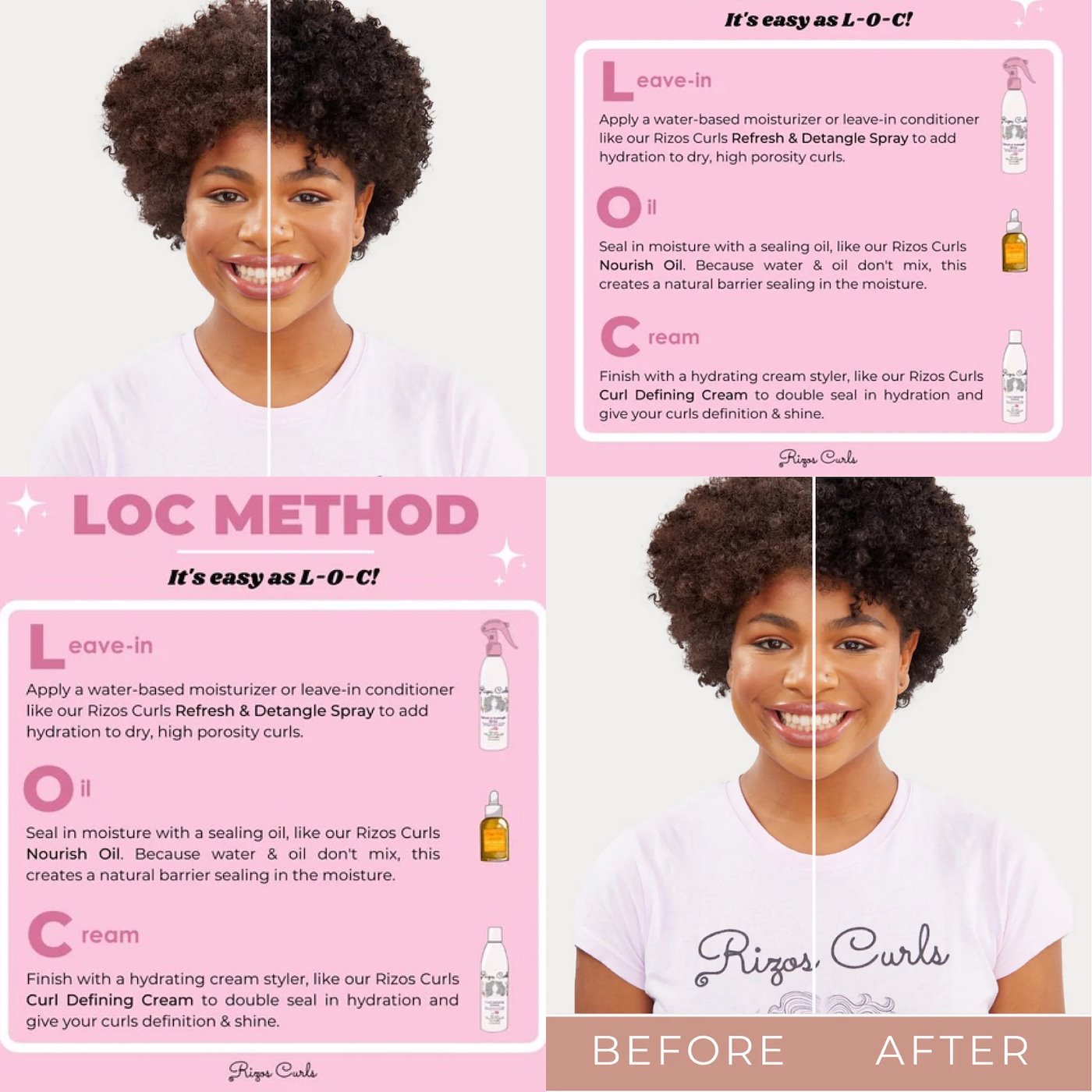
Fabric of Hair Educates: The LOC Method with Rizos Curls🤗
Naturalistas have perfected the technique of the LOC Method in order to maximize hydration, retain moisture and welcome in shinier and healthier coils. If you’re unsure what LOC means or how you can use this method on your type 4 hair, worry not. Here is the break down and key to moisture retention and healthier, bouncier rizos!
First things first: What is Type 4 hair?
Everyone has one or more curl patterns, so understanding your hair type can help you identify your hair’s needs and how to properly style your hair to prevent unnecessary breakage and mechanical damage (i.e. over-manipulating hair, too many ponytails, tight protective styles). Type 4 hair is known for its beautiful, tight coils (tightly curled hair) and small springs that vary in definition and width. When fully dried, type 4 hair has a consistently tight “S'' shape, while the tightest type 4 hair (4C hair) has a “Z” shape.
What is the LOC Method? Why does it work best on type 4 hair?
Some of the biggest hair concerns that consumers have regarding their coily, kinky textured hair is that it’s hard to retain moisture, length and definition. Incorporating the LOC (Leave In-Oil-Cream) Method to your hair routine can address those issues.
The LOC Method is the best way you can keep type 4 hair moisturized because this hair type relies on hydration with water and water-based products, The moisture is sealed in with an oil and then the hair cuticles are closed using a cream to prevent moisture loss. 💖💖💖💖💖
Rizos Curls available Ulta Beauty
Author: Jasely Molina is a proud Afro-Latina journalist + content producer with 3c/4a hair from the Bronx, New York.
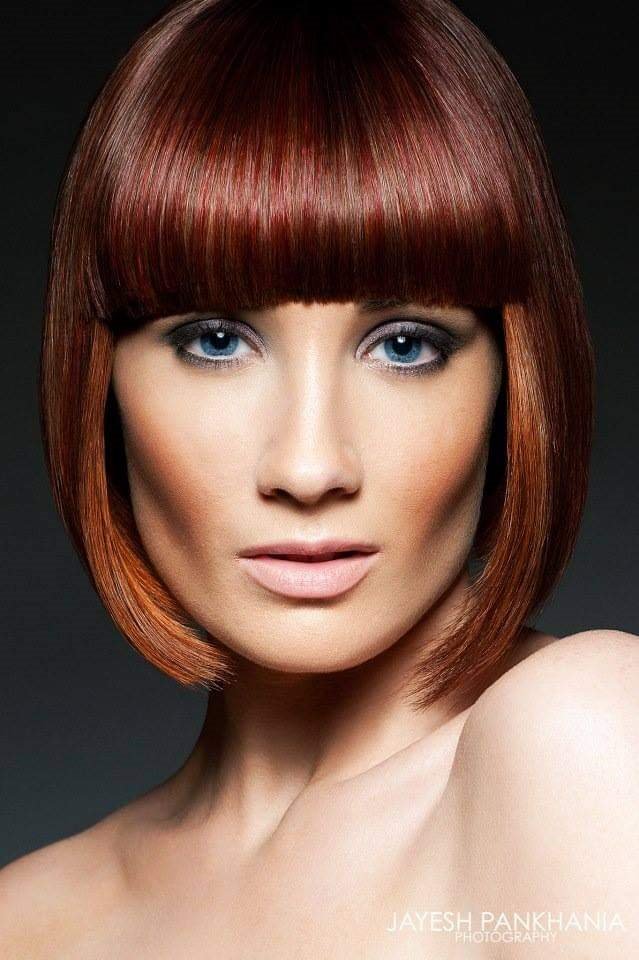
Fabric of Hair Educates: The Bob Haircut and Style
Most people trace the popularity of bobbed hair in Western fashion back to the 1920s, thanks to the haircut's close association with the image of the flapper.
However, the cigarette-smoking, flask-wielding flapper of the 1920s didn't exactly start this trend. In 1920, the New York Times traced the origins of the bob "epidemic" to 1903, when two female students at Bryn Mawr college appeared with short hair to play basketball. The article also claims that bobbed hair became popular in Greenwich Village between 1908 and 1912, thanks to the influence of "intellectual women" from Russia who used bobbed hair to disguise themselves from police.
The bob haircut may have been sported by small groups of rebellious women decades before.
Nevertheless of when it originated, bobbed hair was certainly ideal for the lives of ungovernable young women in the 1920s.
For one thing, the simple bob haircut perfectly complemented the sleek, tubular silhouettes that dominated women's fashion during much of the decade, and the length ensured that hair wouldn’t interfere with any fierce dancing. The distinguishable 'do also helped to fuel publicity for actresses like Clara Bow and Louise Brooks, who is perhaps best known for her razor-sharp cut.
By the start of the 1920s, the bob had become desired by millions of women across all ages and social classes.
While the popularity of the hairstyle has come and gone in mainstream fashion over the past few decades, it's never really disappeared, and somehow it's never lost its strong connection with high style and female empowerment. A newly shorn bob still manages to make headlines each year, especially when linked to a celebrity known for having flowing locks.
Although scores of women have adopted bobbed haircuts throughout history, the style still manages to disrupt mainstream, patriarchal beauty ideals in Western society in a way that makes it one of the quintessential symbols of feminist fashion.
Photo: Jayesh Pankhania
Hair, Wig Design and Color: www.EugeneDavis.Hair
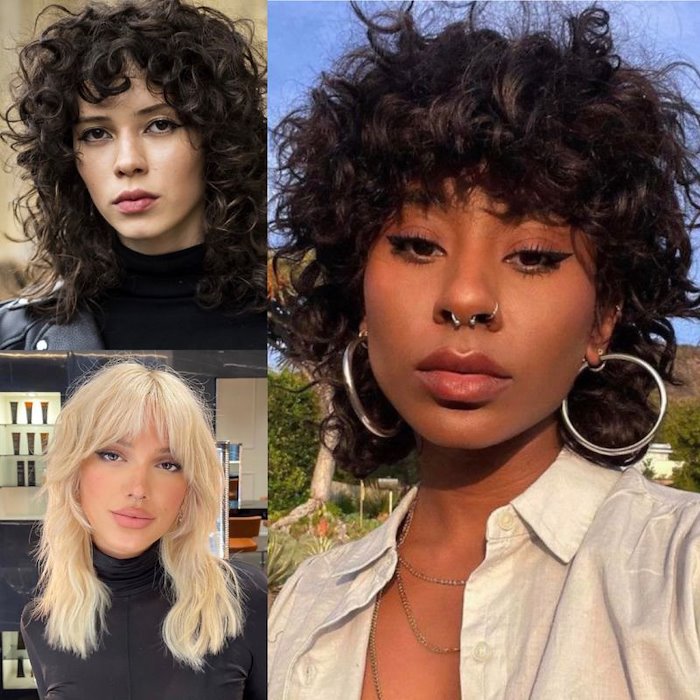
The Wolf Hair Cut, Still Trending in Fashion ⭐️
The wolf cut is a haircut that is similar to a hybrid shag or pixie style, but the hair on the top of the head is left longer.
The length of this cut can vary depending on how long you want the hair to be.
This haircut has its origin from the Island of Jamaica and it has been popular among celebrities in the know for many years now.
The wolf cut has a history of a past trending haircut that was popular in the 1940s.
Fashion trends are always changing with the times and location. This technique is one of the most intriguing hair cuts with fashion leading the movement.
The Wolf Cut Hairstyle:
This haircut looks stylish with a lot of volume and a bit of a messy look. It is perfect for those who want to give their look a little bit of edge.
It’s also a very easy hairstyle to maintain as it only requires washing and styling by adding your favorite product.
Wolf cut is a trend that has gone viral, It is an alternative to pixie haircuts. Wolf cut gives off a fashion forward vibe.
The wolf cut haircut is a elevated hairstyle that isn’t for the faint of heart. 🤩🤩🤩🤩🤩
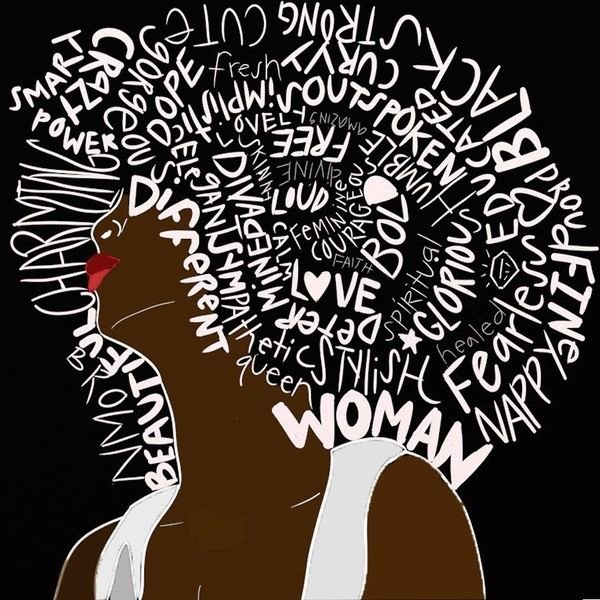
Fabric of hair Investigates: In What Way Are Black Hairstylists, Makeup Artists and Creators Really Being Supported ?
Hair, Beauty and Makeup are becoming an invaluable voice within major beauty brand markets. Or better put, that invaluable voice is finally being listened too.
If a system doesn’t work for you or excludes you, do you fix the system?
Or build your own?
The black hair and beauty industry is worth an estimated $2.58 billion, and the button g power of black consumer is projected to be a staggering $1.8 trillion by 2024 with black consumers spending six times more on hair care than their white counterparts. It’s hard to fathom why so many huge companies chose to ignore that market by not involving consultants that know the community.
This lack of support create a number of black hair and beauty entrepreneurs, who began to lovingly develop their own products, they themselves so desperately needed.
Exhausted of being under-served or ignored. Propelled by the natural hair move movement, created product makers, service providers, influencers, hair an d makeup expert educators, knowledgable consumers, all intermixed in supporting a grassroots rejuvenation in the black hair and beauty care.
With this acceleration of business and development, we have seen black creators not only developing their own, but also taking on roles in predominantly white spaces and helping to regulate the industry at large.
While it's some progress that these conversations are happening, it is important to note this is more so about dismantling generations of systems that have been put in place to keep Blacks out of the decision-making process. That mindset has to change right now. There’s an exigency to be seen and heard in all parts of hair and beauty industries.
Insistence to be a part of the decision-making process. Our voices and shared experiences are powerful and we bring with us overwhelming knowledge. This is not about condolences and just throwing investment here and there, it's about digging deep and really valuing us and our input into the hair and beauty industry marketplace.
Art Work by: https://lnkd.in/gDvbTAmU
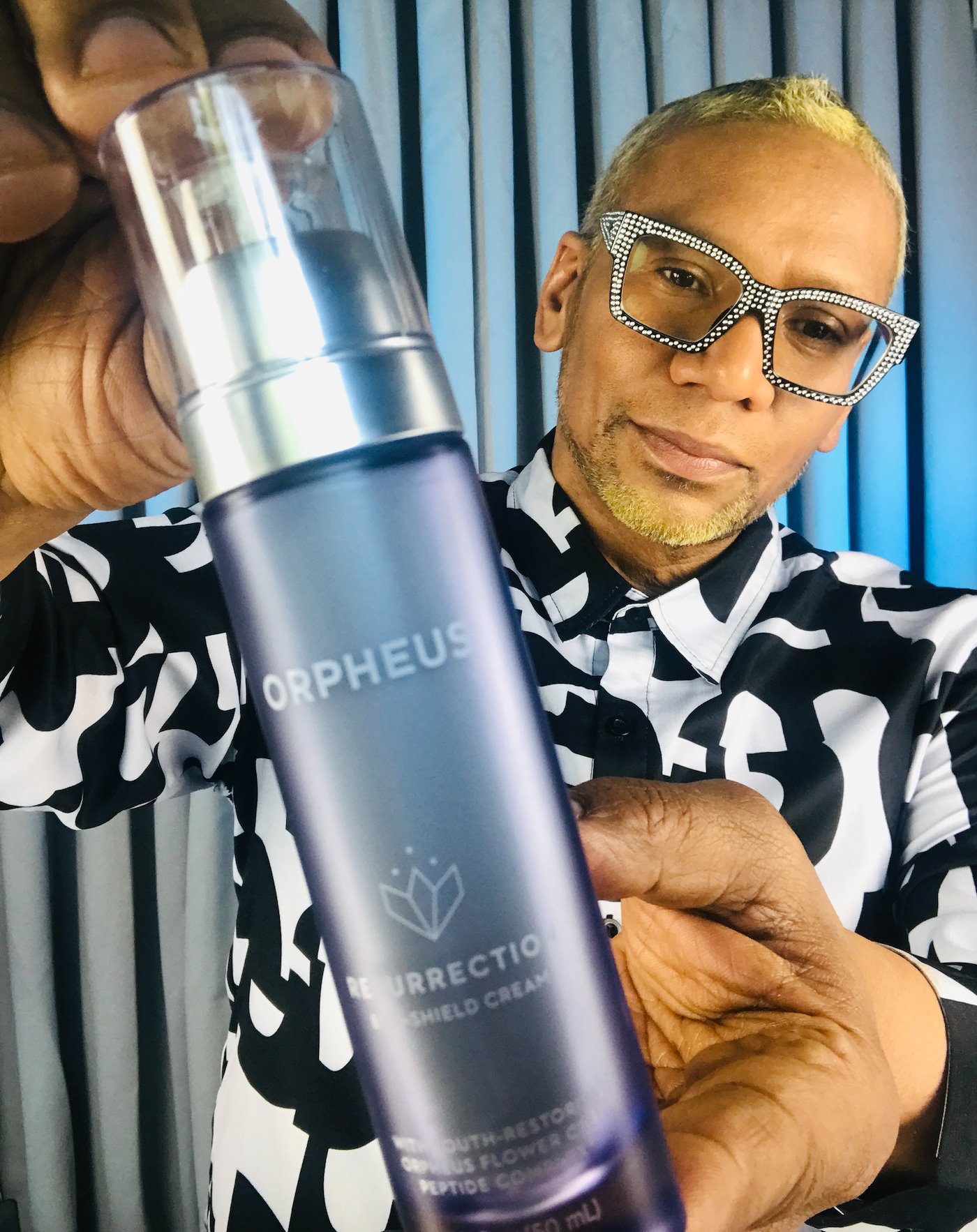
I have struggled for a long time with keeping my forehead area hydrated, due to loss of moisture as a result of using medicated shampoos with steroids for my Seborrheic Dermatitis. As a result of this condition my skin was always dehydrated and flaky. Nothing I tried seem to keep my moisture level balance for any length of time.
Most products where heavy and left my face looking like I put cooking oil on it, until I tried Orpheus Resurrection BIO-SHIELD CREAM.
This Intensive restoring cream that repairs damaged skin barrier and shields skin from moisture loss and pollution, with a silkening all encompassing calm effect.
A creamy texture which I love, its rich yet delicate misty texture melts directly into skin forming a breathable bio-shield and delivering an instant healthy glow with hydration you can feel.
The five potent barrier-strengthening bioactives reinforce each other to help skin rebuild its natural barrier, seal in moisture, reduce inflammation, and shield skin from pollution, blue light oxidation, environmental stress and cold climate for a smoother, replenished appearance.
Ive tried a lot of products with amazing resulted claims, with substandard effect.
However I am impressed and happy with Orpheus Resurrection BIO-SHIELD CREAM.
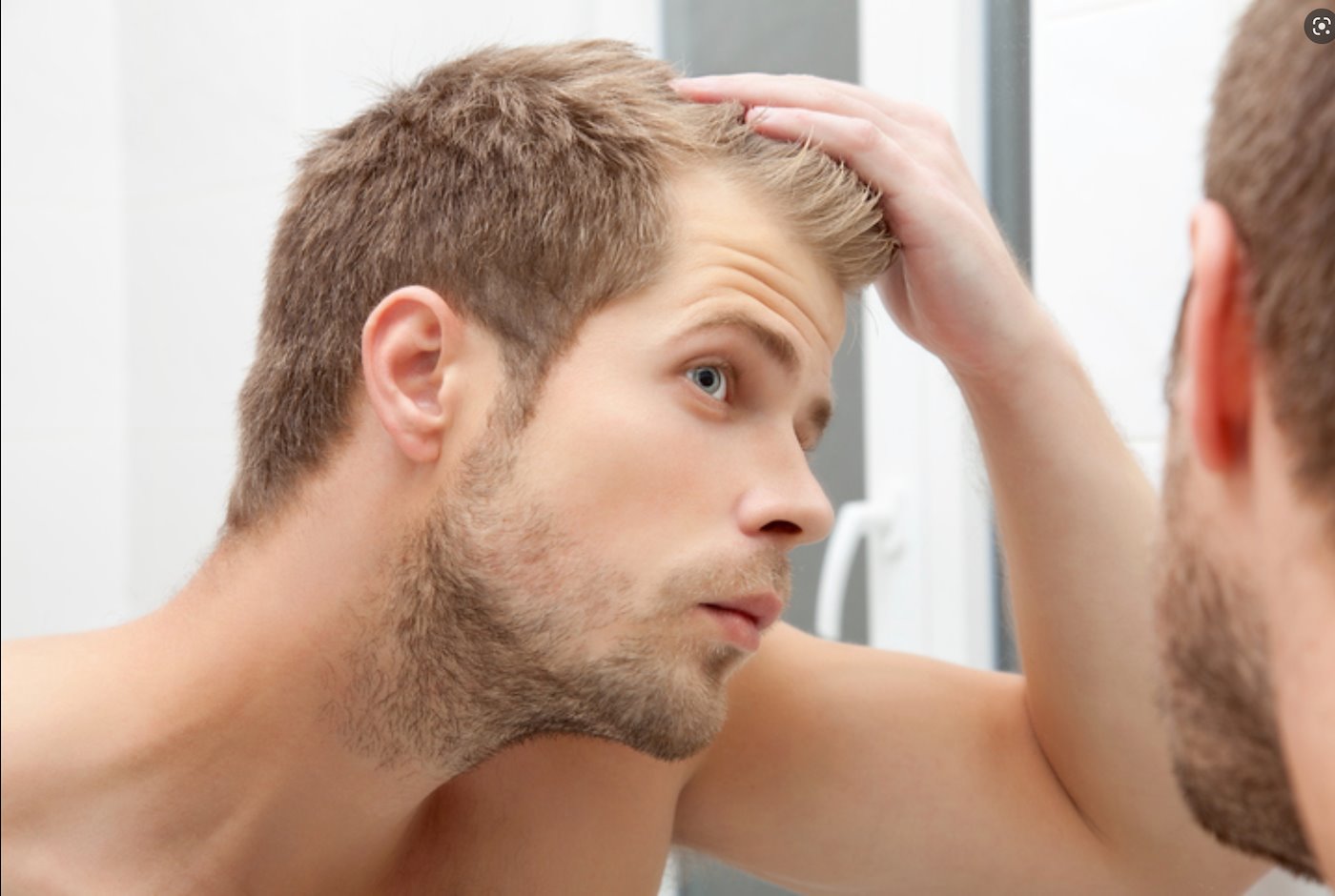
Fabric of Hair Investigates: Scalp Health 🧐
Humans are complex organisms. So complex, even, that the average adult human is made up of over 100 trillion microbes, tiny single-celled organisms that form symbiotic relationships with larger, more sophisticated organisms.
The billions and trillions of microbes combine to form a “microbiome,” which are found throughout our bodies - especially in our guts, stomachs, and skin. These are the habitats in which our microbes live. And, believe it or not, the health of our microbiomes determines how healthy we are as human beings.
If you want to learn how your scalp microbiome affects your overall health, and how you can prevent common skin and scalp conditions like flaking, seborrheic dermatitis, and psoriasis.
Lets take a deep dive into everything there is to know about the scalp microbiome and how you can “hack” it to maintain a healthy scalp and stay dandruff-free.
The Micro..
The scalp microbiome is a community of simple organisms that grow on the skin on top of your head. In this habitat, a diverse mix of bacteria must work together, and each do their part to contribute to your scalp health. If the delicate balance is thrown off, you can develop unfortunate skin conditions like flaking, itching, and irritation.
Similarly, when your scalp’s microbiota are out of whack, you can develop rashes, flaking of the scalp, itchy skin, androgenetic alopecia, and more.
The good news is, it’s easy to take good care of your scalp and skin microbiome with the right set of products.
Dandruff and The Microbiome
Scientific studies have confirmed that dandruff and the scalp microbiome are intimately connected. Even individual hair follicles have microbiomes.
Scalp Structure 101
It is important to find out what the scalp is and why its microbiome is important. Otherwise, it’s difficult to understand, what’s going on in your head and how the bacterial cultures that grow they’re relate to dandruff conditions like flaking, dry scalp, and oily scalp.
The microbiota of the scalp is unlike any other microbiome on the body, even the rest of your skin microbiota. Due to the high volume of vitamin-rich sebum production in the sebaceous glands and the unusually humid environment, the scalp gives rise to cutaneous bacteria, genomes, biofilm, pathogens, and microbes that aren’t found anywhere else.
If you’ve come down with a bout of dry scalp, flaking, or a related dandruff condition that’s left your head itchy and uncomfortable.
Chances are, there’s an underlying problem with your scalp microbiome. Fortunately, there are steps you can take to enhance the state of your scalp microbiome and relieve the symptoms of your condition. 💛💛💛💛💛
#eugenedavishair #hairexpert #haireducation #scalpcare #microbiome
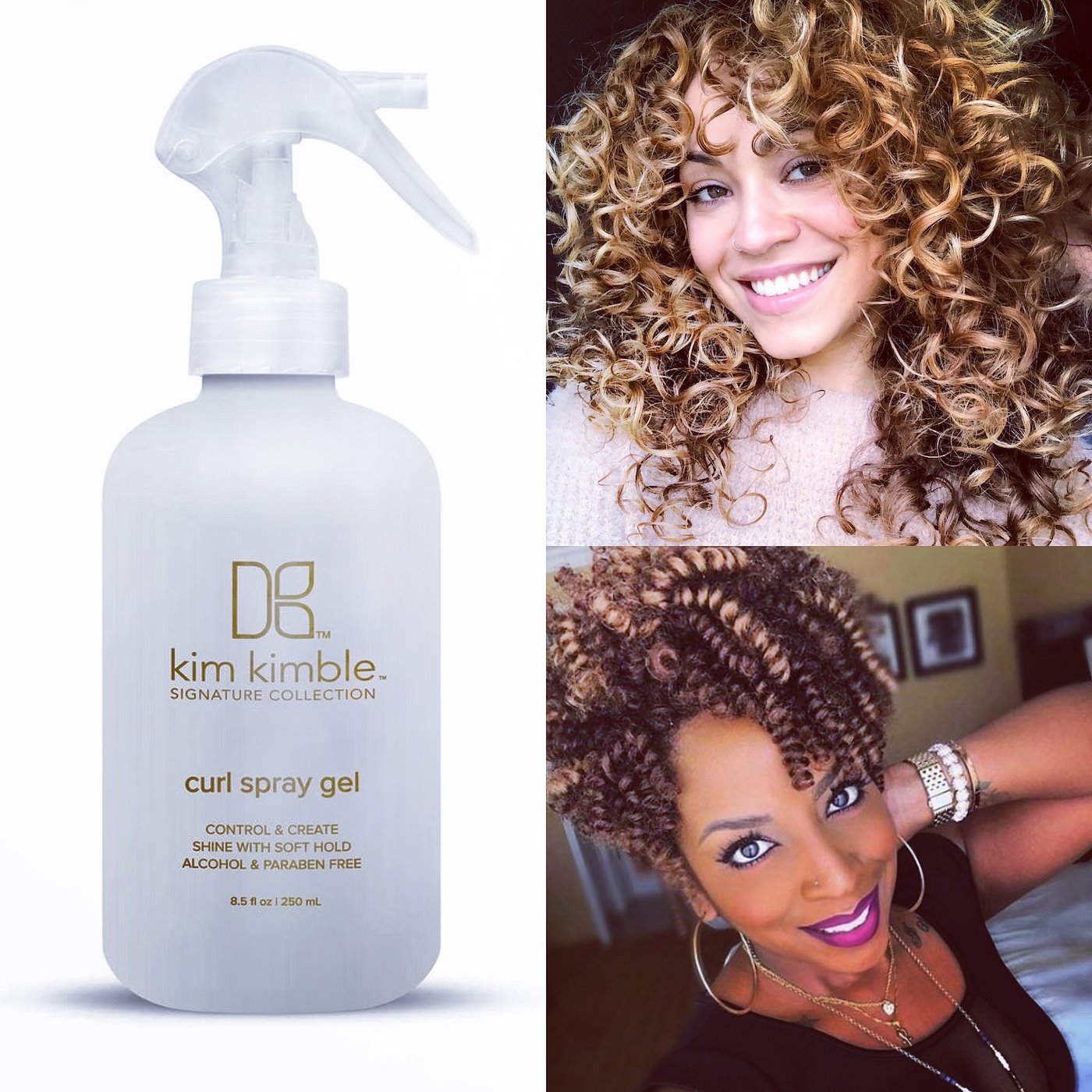
Fabric of Hair Educates: Finger Coils, What ya Rolling With👆🏽👆🏽
What’s a Finger Coil?
A finger coil is a type of curl achieved by wrapping your hair around your finger. The end result is these tight and bouncy coils in your hair. They are fun yet professional and full of volume! The key to amazing results for your finger coils is a little bit of patience and a whole lot of care. If you take your time to do your finger coils properly, they can last up to a week or even longer! The fun thing with finger coils, is that they work on all hair types and curl patterns no matter how long or short your hair is.
Tip: Finger coiling is a great technique to gain enhanced definition from your curls. It can also help retrain your curl pattern back into shape, especially after heated tool straightening. ➿➿➿➿➿
Featured Product: Kim Kimble Curl Spray Gel
Control frizz and boost shine of your naturally curly, wavy, or permed hair. It provides bouncy long-lasting hold without stickiness or buildup.
How to apply:
Use Curl Spray Gel, Spray a generous amount to slightly damp hair. Scrunch, diffuse with the blow dryer, or let dry naturally. To create ringlets, twist the hair around fingers and release.
@Kimberly Kimble
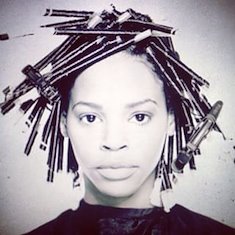
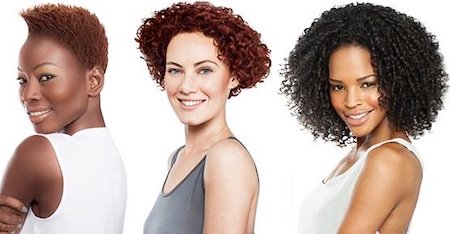
Fabric of Hair Educates: The Straw Set for Summer Curls 🥸
Straw set curls are a tight version of corkscrew curls, popular in the mid-20th century. The straw set method of curling hair is used for naturally curly hair, African American hair, as well as straight and chemically relaxed hair.
Drinking straws and bobby pins are essentially all that are needed to create this curly, versatile hairdo.
The diameter of the drinking straw determines the diameter of the curl.
The Process:
The first step in the straw set method is shampooing and conditioning your hair according to your usual nourishing wash routine.
Prevent breakage of hair by using a wide-toothed comb for detangling.
Assemble straw set curl supplies: a rat-tailed comb, hair clips, drinking straws, setting lotion and bobby pins.
Note: Scissors are also needed if you plan to cut the straws.
Straw Set
A straw set allows you to gain control of naturally textured hair, but it is also a popular style for people with straight hair who want lots of curls.
Short hair can also be set with straws in horizontal ↔️or vertical rows↕️.
Medium-length or long hair should be set in vertical rows↕️
For short, horizontal rows, cut straws to the desired length. Medium or long hair uses full-length straws.
Curling Hair
Setting lotion is applied to strands of hair before each strand is twisted around a straw.
Fasten the rolled hair to the straw with bobby pins inserted into the straw at the top and bottom.
Smaller sections create tighter curls; larger sections create looser curls.
Style
After hair is completely dry under the dryer remove hair pins and gently twist each straw back and forth to dislodging it from the straw without disturbing the curl.
Leave hair as it is, or rub a small amount of oil into the palms of your hands and run your fingers through your hair for a loose curly effect.
🤍🤍🤍🤍🤍
Wash & Condition:
1.Almand & Avocado
Sulfate Free Shampoo
2.Almond & Avocado
Conditioner
Set:
Design Essentials
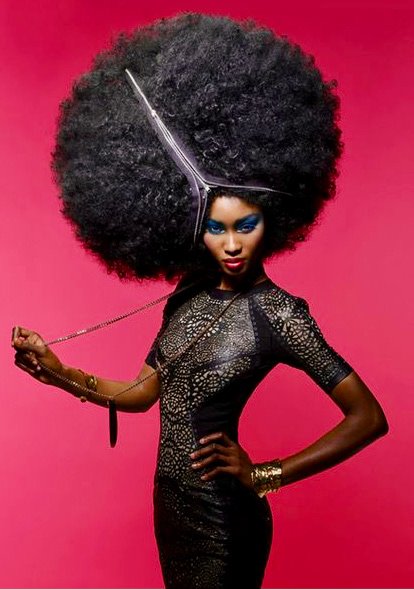
Fabric of Hair Educates: Un-Zipping the Myth of Black Textured Afro Hair 🤓
For much of American history, naturally curly black hair has been wrongly seen as unprofessional or even tarnished, especially in the workplace.
The expression of beauty through hairstyles has been a long-standing signature of Black culture. From the "fro" to hair wraps to braids, Black women use their hairstyles as a personal expression of who they are and to show the evolution of Black culture over time, an evolution which has brought us to a time when more and more Black women are embracing the natural beauty of their own hair.
However, it doesn't escape controversy of what is considered beautiful, specifically hair in modern culture. It is sensitive topic of discussion and has been for decades that has been implanted all the way back to the Civil Rights Movement.
As with any topic that garners passionate responses, one must look at hair and cultural identity within the Black community for context. Social oppression, abuse, and racial discrimination have historically forced many Black women to hide their hair in humiliation.
Abandon Negative Self-Talk
Recognizing, confronting, the negative beliefs that have been acquired about Black textured afro hair, and stop the discouraging self-talk. Ignoring the negative bombardment is negative statements from others. Hearing phrases like: "tame your frizz”; “your hair isn’t professional”; “it’s too big”;”its to wild”; “why don’t you just tie it up?”, straighten or relax it”. The constant infamy of statements have lead to hair insecurity.
Hearing this as a constant drone of veiled ‘constructive criticism’, from childhood, teenage years and even into adulthood. This negativity can cause lasting damage not just for our hair health, but mental health, self-esteem and self-identity.
Due to the previous lack of support in the hair industry, representation and education around Black Textured Afro Hair and caring for it. It has taken some time for the community to unlearn all the negative biases. However, It is clear that Black Textured Afro Hair is on the positive, supportive hair image journey.
Truth is, having realistic expectations of your hair is key to building a lasting relationship with it, so make sure you treat yourself, and your hair, with the identical compassion you have with others.
Let go of the idea of perfection and remember that faultless, ‘frizz-free’ hair simply doesn’t exist, and healthy is the ultimate goal.
Note: Frizz is a great quality of healthy hair! 💛💛💛💛💛
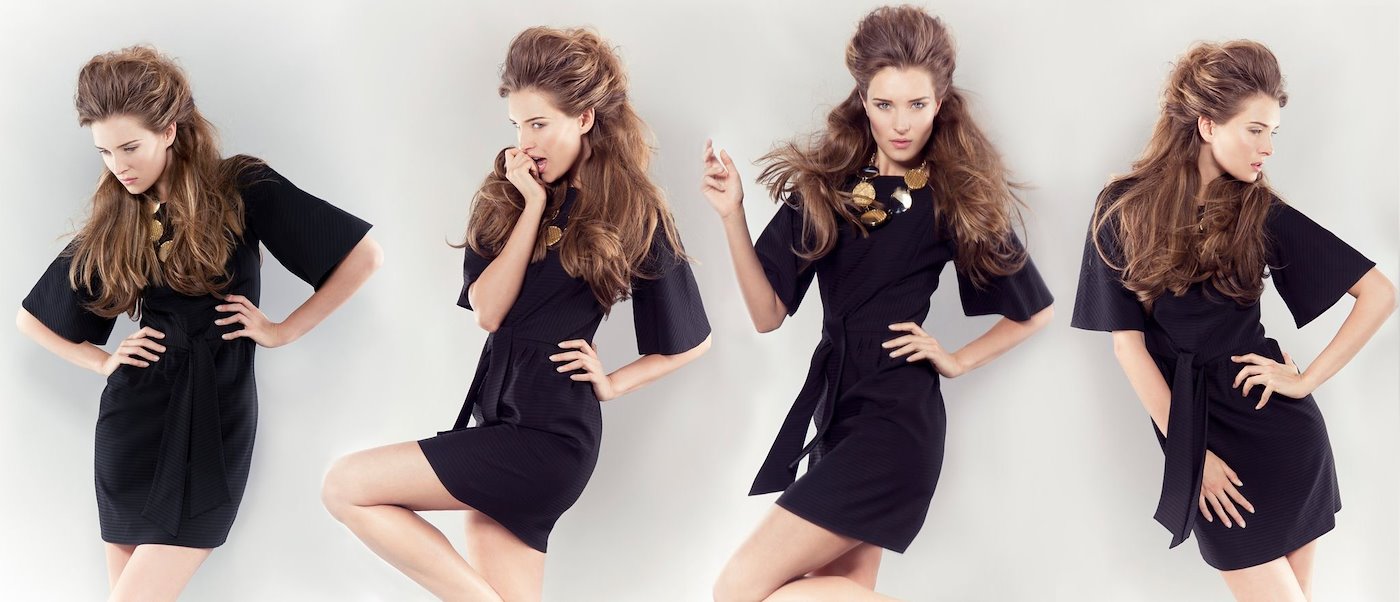
Fabric of Hair Educates: Texture Sprays🤓
Have you been trying to get I-woke-up-like-this, messy-yet-still-put-together hair?
Of course, not all texturizes are the same, and some can leave your hair feeling crunchy, sticky, and heavy. So for whatever look you want to create, whether you’re trying to pump up your flat hair or add a lived in texture to your waves there are texturizing sprays that’ll help you get the perfect messy hair.
What does a texturizing spray do?
Texturizing spray gives your hair, controlled texture, but it also boosts volume, creating definition, absorbs oil, and adds grip and hold to your hair.
A texture spray can give you that fashion look without the chalkiness that some dry shampoos can leave behind.
There are many different types of texturizing sprays. Choosing the best texture product for you depends on a multitude of things. In order to find the correct texture spray for your needs, You should know what type of hair you have. This includes the thickness, the condition (dry, color-treated, etc.), and what kind of hairstyle you're trying to achieve.
If you have thick, coarse, or color-treated hair, you should look for a product that boosts hydration and protects your color, versus if you have fine hair, you should look for a lighter or gentler formula so your hair is not weighed down.
Expert Tip: The best thing to keep in mind when applying texture spray is that if you’re not careful and apply too much, texture spray can sometimes make dry hair look even drier. To avoid this mishap, build the product up. That way, you can add more slowly and gradually until desired texture is achieved.
BEST FOR COLORED HAIR:
Drybar Triple Sec 3-1 Finishing Spray
Drybar
BEST FOR NATURAL HAIR:
Briogeo Blossom & Bloom Ginseng + Biotin Hair Volumizing Spray
Briogeo Hair Care
BEST OVERALL:
Oribe Dry Texturizing Spray
Oribe Hair Care
BEST FOR CURLS:
Virtue Create Texture Spray
BEST FOR FINE HAIR:
Sam McKnight Cool Girl Barley There Texture Mist
Hair by Sam McKnight
⭐️⭐️⭐️⭐️⭐️
Photo: Sarsh Louise Jhonson
Stylist: SELINA DAVIS
Model: Dite
Makeup: Laura
Creative Director/Hairstylist Eugene Davis
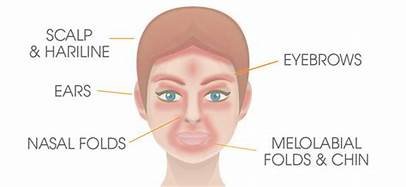
Fabric of Hair Investigates: Scalp Issues, Seborrheic Dermatitis🧐
What is seborrheic dermatitis?
Seborrheic dermatitis is an inflammation of the upper layers of skin, characterized by red, itchy skin that sheds scales. Seborrheic dermatitis may be a hereditary condition. It is often aggravated by hormonal changes and cold weather conditions.
Seborrheic dermatitis is most common during middle age. When seborrheic dermatitis happens at this age, the condition is usually more intermittent and called dandruff. People with oily skin or hair are also more at risk for developing seborrheic dermatitis.
What are the symptoms of seborrheic dermatitis?
The following are some of the other symptoms associated with seborrheic dermatitis. However, each person may experience symptoms differently.
Symptoms may include:
Itching scalp,
Dry or greasy scales on the scalp,
A yellow or red scaly rash along the hairline, behind the ears, in the ear canal, on the eyebrows, around the nose, in creases on the arms, legs, or groin, and/or on the chest.
How is seborrheic dermatitis diagnosed?
A complete medical history and physical exam helps the healthcare provider in diagnosing seborrheic dermatitis.
The condition responds to treatment, it may happen again. Treatment depends on the inflammation's location. It is usually effective in relieving symptoms.Treatments may include:
Anti-inflammatory creams or lotions, such as corticosteroids or calcineurin inhibitors
Antifungal topicals
Over-the-counter dandruff shampoos
Medicated shampoo for adults, as prescribed by your healthcare provider
Natural Remedies
Traditional treatments for Seborrheic Dermatitis mainly consist of harsh dandruff shampoos and dangerous topical steroids. The problem with these conventional treatments is that they're usually ineffective, unsafe, only treat one symptom, have severe side effects, and the results don't last.
A slightly better solution would be one of the few natural home remedies that seem to get results...like apple cider vinegar, raw organic honey and aloe vera.
Essential Oils
The best way to get quick and lasting relief from Seborrheic Dermatitis is with certain essential oils. You may have read that Tea Tree oil is effective against Seborrheic Dermatitis. Well that's a fact, Tea Tree oil works great. But if you stop there, you're missing out on a whole array of different oils that can greatly amplify that effectiveness.
For example Neem oil, Cedarwood oil, Patchouli oil, Lavender oil, Rosemary oil, Oregano oil, Peppermint oil, and Eucalyptus oil all have proven properties that can quickly relieve Seborrheic Dermatitis symptoms. In fact Oregano oil is one of the most powerful antifungals (kills yeast) available, and it's all natural!
Although seborrheic dermatitis is itchy and uncomfortable, it does not harm your health. The condition can be managed with treatment. Itchy skin and white flakes on your black shirts shouldn’t be a normal part of your lifestyle.
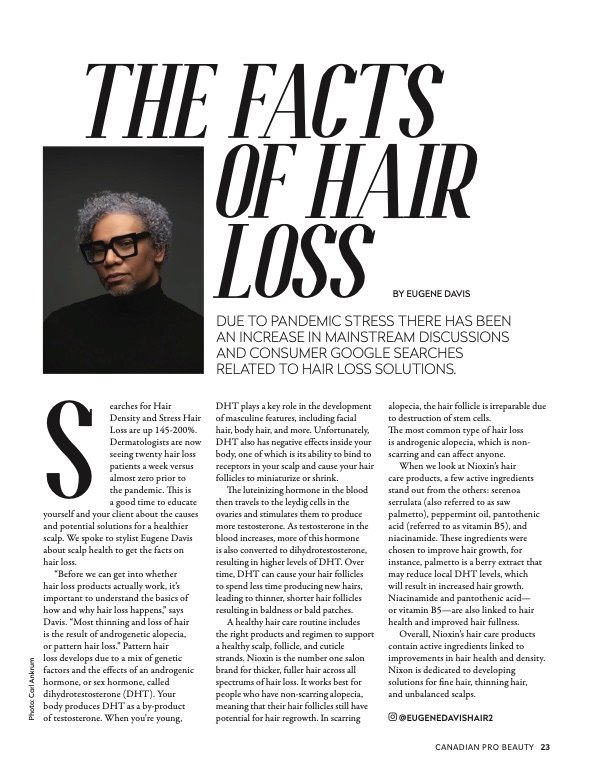
Thank You Cheryl Gushue for inviting me to be a Contributor in the Spring/Summer 2022 issue of Canadian Pro Beauty Magazine.
@canadianprobeauty
www.canadianprobeauty.com
Featured Product:Nioxin Research Laboratories, Inc.
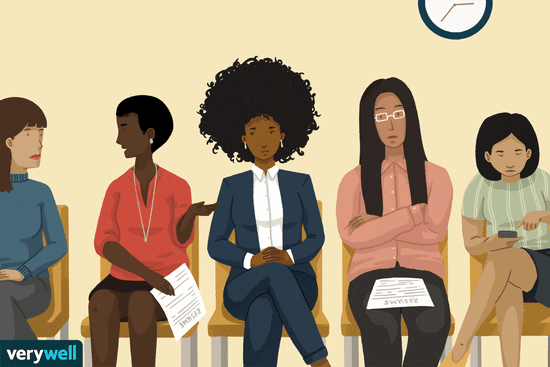
Fabric of Hair Investigates: Is Fashion, Beauty & Hair industry without bias post-pandemic? Or it the same game, different angle?
Let's start with an industry that claims to be in the in the deep and know of beauty, the number of inequalities of the $2.5 trillion fashion ecosystem aren’t very appealing to those who are non-white.
The path to success for Black creatives is journey set with pre-carefully orchestrated obstacles, disadvantages, setbacks, disappointment and compromise.
The results of the well-documented systemic racism and unconscious bias in fashion industry, retail, beauty and haircare institutions and businesses.
Black designers and fashion editors run and endure a good race for equal footing with their peers, but often lack the networks and connections that could help open doors to jobs can be disheartening. When they’re ready to step out on their own, funding, showroom representation, brand support and wholesale distribution can be a challenge with out a industry, that supports you for your talent and character.
With fewer industry role models in positions of power and influence and, historically, less representation in fashion magazines, envisioning a future in the industry has required imagination, a single-minded focus and resolute confidence that your voice and innovation does not matter.
Then there is the micro-aggressions. Being tested with questions that would not be normally asked if you where not black or brown, all simply to see if they could get under your skin.
There’s an intimidation factor, that's unwarranted and unfair. Unfortunately most people asking these questions, don't even know their bias is built into they’re DNA as a community.
So now you have to tone down my confidence level, a little bit and then a little bit in order to at least get your foot in the door.
Observing others with less talent but the simple fact they were not the descendants of forced slavery in America get funding, without having a penny in revenue, just skin color and privilege.
African Americans drive $1.3 trillion in spending in a national Hair, Skincare, Makeup and Personal care. We are in many ways the creators and major contributors of American culture.
To be blunt if you look a social networks and money invested into the influence market there's no American social culture without Black culture.
⭐️⭐️⭐️⭐️⭐️